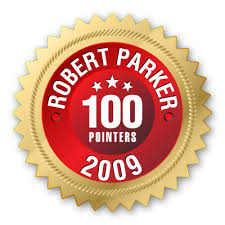A while back, I purchased five current offerings of Los Vascos wines (LINK) from Wine.com (LINK) to do a tasting. Los Vascos is the Domaines Barons de Rothschild (Lafite) holdings (since 1988) in the Peralillo area of the Colchagua province of Northern Chile. I have blogged about Los Vascos Cabernet Sauvignon before (LINK).
The wines were:
2015 Sauvigon Blanc, retail $14.00
2014 Chardonnay, retail $8.99
2014 Cabernet Sauvignon, retail $8.99
2012 Cabernet Sauvignon Grand Reserve, retail $20.00
2012 Carmenere Grand Reserve, retail $20.00
I did not get the rosé (90% Cabernet Sauvignon, 10% Syrah, retail $11.99), or the LE DIX (retail $65.00), which is their highest-end Cabernet which were both available at the site, but are generally not available locally.
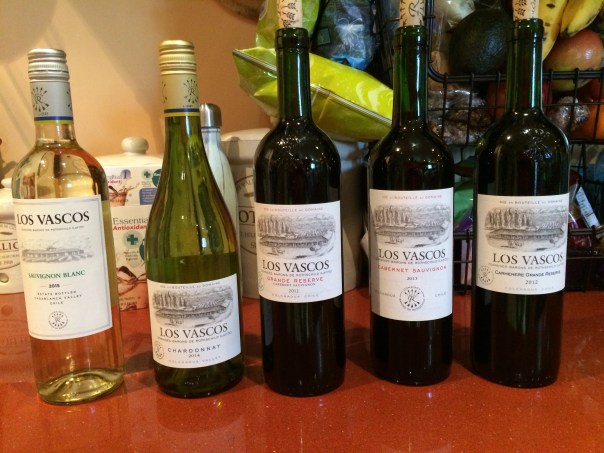
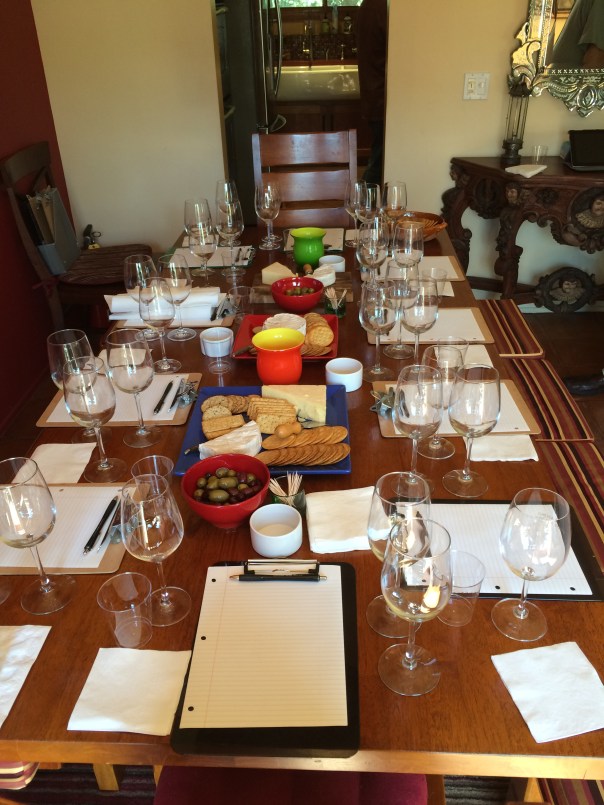
For the tasting, ten of us gathered at the home of Mary Stec and Richard Clark. Richard is the winemaker for the Conejo Valley Wine Co-op (LINK). Those joining Dorianne, Richard, Mary and me were Steven and Diane Brabant, Brad Kieffer and Karen Oxrider, and Doug and Corrine Draper. All of these folks know wine very well.
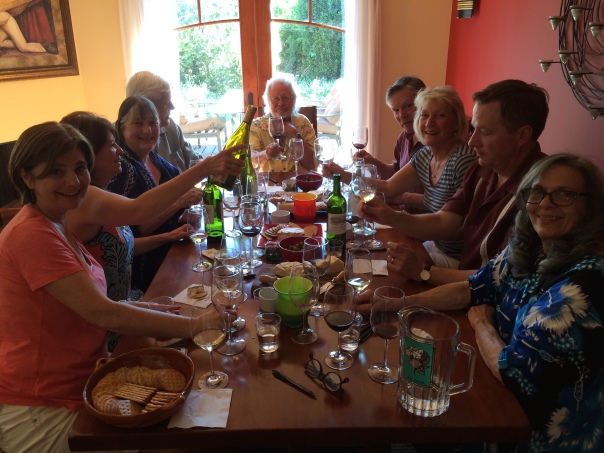
The tasting of these wines, which fall into the Everyday Wine category, was to get a sense of the product line of a South American Producer who has a couple of big sellers in the U.S. market, but also has some other wines that are a bit harder to find, but are around. I judged the two wines not included as too difficult to find in retail stores.
The red wines were opened about an hour before the tasting. All of the wines were kept at about 50 degrees Fahrenheit in Richard Clark’s wine cold room, where they have been for about 6 weeks. We served a variety of cheeses, crackers and olives with the tasting, which did affect how the wines tasted. Everyone tasted each wine and made personal notes before we all discussed the wine. The wines were tasted individually, although the Cabernets were poured at the same time to allow for comparison.
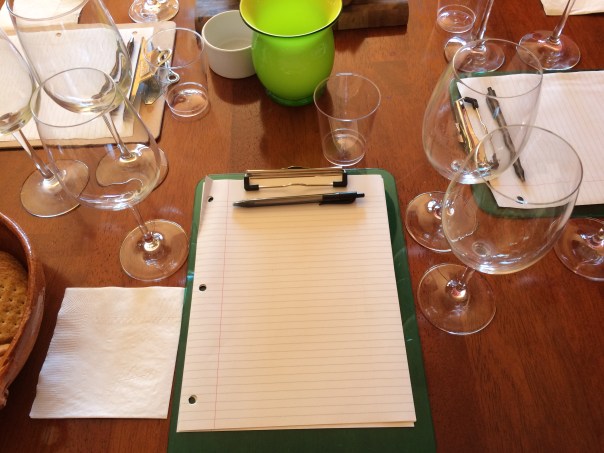
The tasting notes and the conversations revealed what you might expect – there was some agreement and some disagreement about each of the wines. There was a rage of opinions as to the presence of tannins in the Reserve Cabernet Sauvignon, for example. Almost everyone noted the presence of grapefruit-citrus in the Sauvignon Blanc, but not everyone. Some found the Grand Reserve Carmenere very smooth and a couple of people found it to be harsh.
Some comments about each wine, with an attempt to capture the essence of the notes and comments from the group for each:
2015 Sauvignon Blanc: light, citrus/grapefruit with a hint of tangerine, lemon grass, high acid, crisp, New Zealand style, mineral finish; better with food than alone.
2014 Chardonnay: Minimal nose, hints of butter, crisp, light, hints of nuts, minerality, more like a Pinot Gris, pear, apricot, neutral oak, not much of a finish; improved with the cheese.
2014 Cabernet Sauvignon: Nose red fruit, alcohol, ashes, acid; thin, minerals, hint of cherry (minimal fruit), slightly astringent finish; also improved with food.
2012 Grand Reserve Cabernet Sauvignon: Inky red color; plum, ripe fruit, cassis on the nose; balanced tannin, acid, and fruit (one comment too much tannin, needs longer decanting); nice finish; needs some time – 2 to 3 years; more substantive than the 2014 Cab, but still a bit thin for a Cabernet Sauvignon. Clearly a superior wine to the 2014 (with one dissenting opinion on that).
2012 Grand Reserve Carmenere: Dark, inky color; rich bouquet of black fruit, green pepper, cloves and spice, tobacco, earthy soil on the nose; nicely balanced with light tannins, hints of currant, prune and figs; smooth finish; approachable wine; described as “smooth” and “harsh”; “pick of the litter”; would be great with lamb.
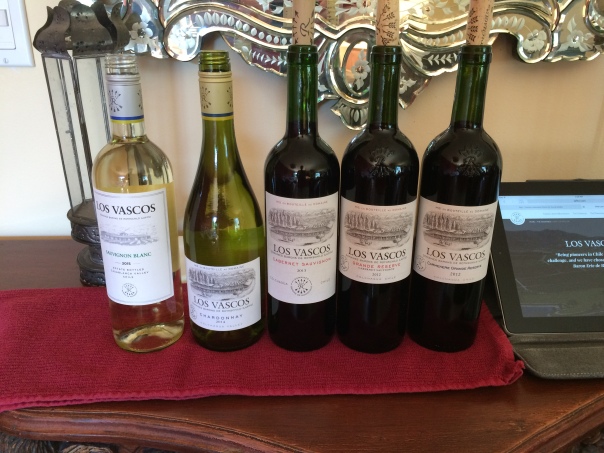
I asked each person to rate the five wines from 1 through 5 in terms of their impressions of the realizing this has an apples to oranges quality, but aiming at which of these would you be most likely to purchase yourself?):

The upshot – all of these wines are drinkable and have both positive qualities and drawbacks that are largely subjective. Los Vascos wines are reliable go-tos for everyday drinking. If your budget calls for the inexpensive Chardonnay or Cabernet Sauvignon, go for those – even though the Chardonnay was not well reviewed by the group, several people liked it very much – at $9.00 or so, you can find out for yourself; if you can upscale a bit to the Grand Reserves, you will find a good increase in value at the higher price-point. The Sauvignon Blanc is at a good price-point if you enjoy a citrusy New Zealand-style, and grab that Grand Reserve Carmenere if you can find it.
Two of us (Steven and I) who had first encountered the Los Vascos Cabernet Sauvignon in the 1980’s and early 1990’s noted that it seems to be a very different wine than in those days. A reading of the website (LINK) bears this out, as extensive replanting has occurred since that time. And, both of us are drinking wines at higher price-points today, which may also be a significant factor in our impressions. Perhaps we have changed along with the wine.
Comments about your experience with these wines is, of course, most welcome.
Copyright 2016 – Jim Lockard


